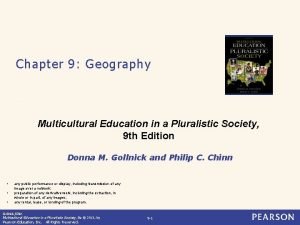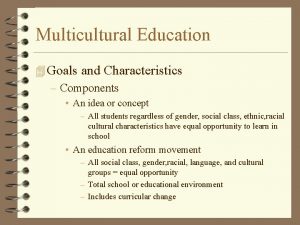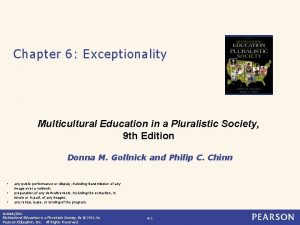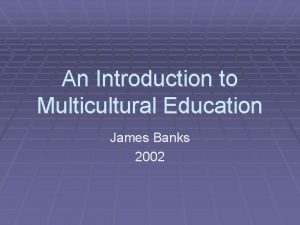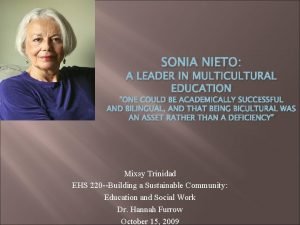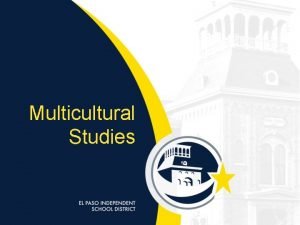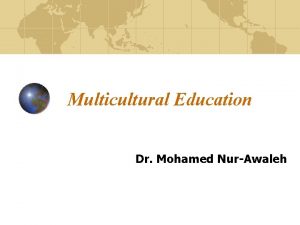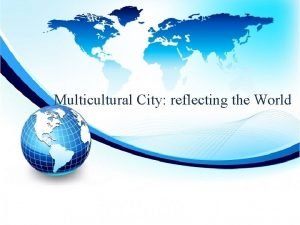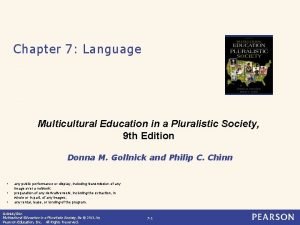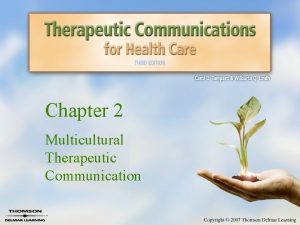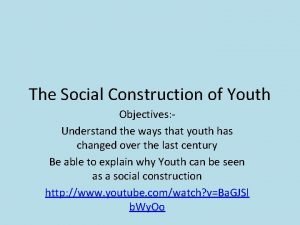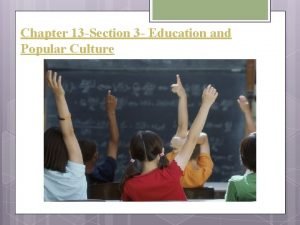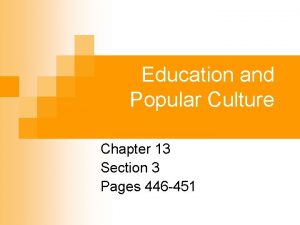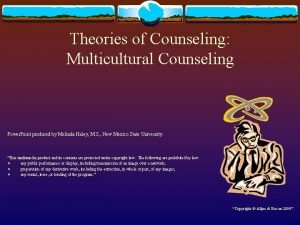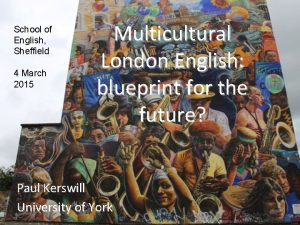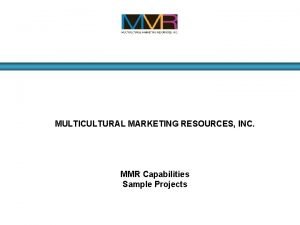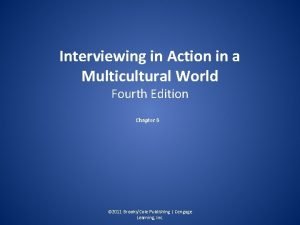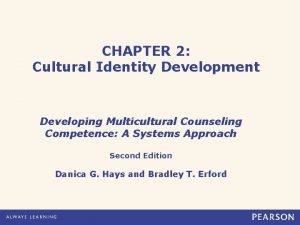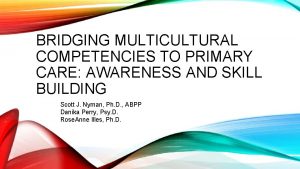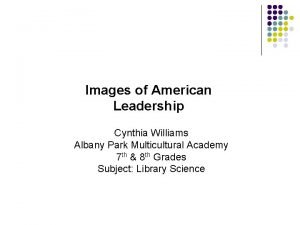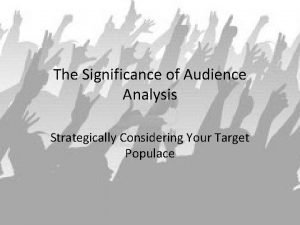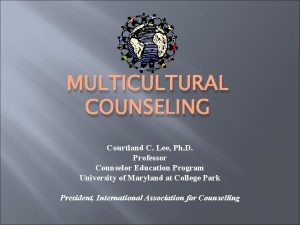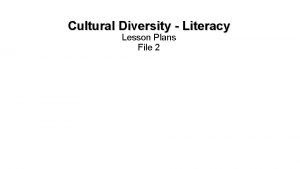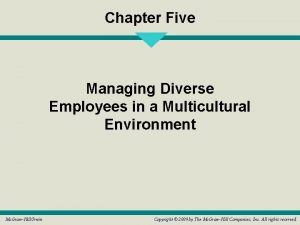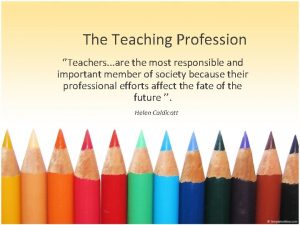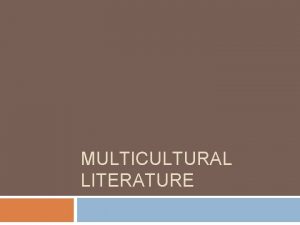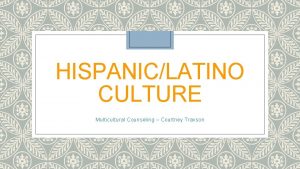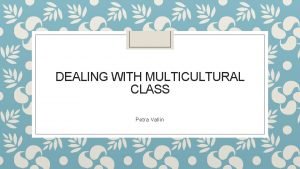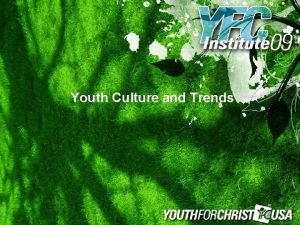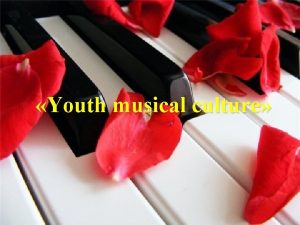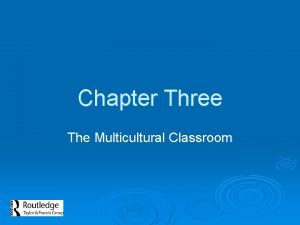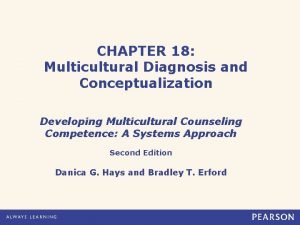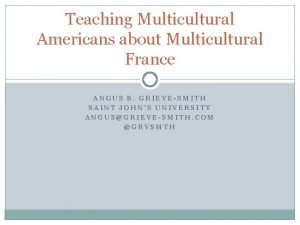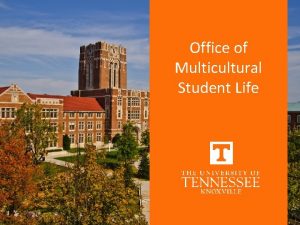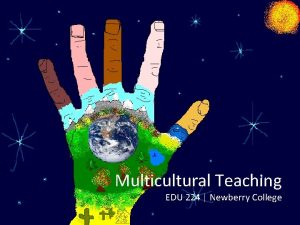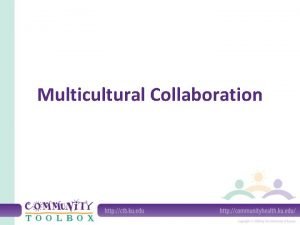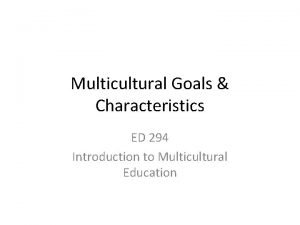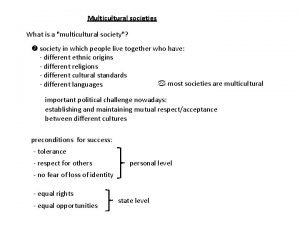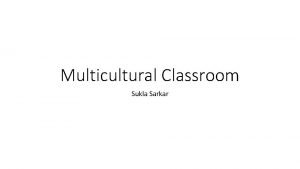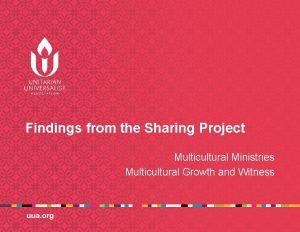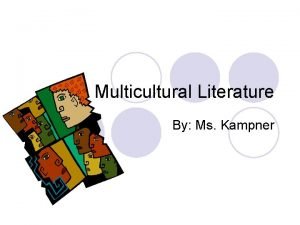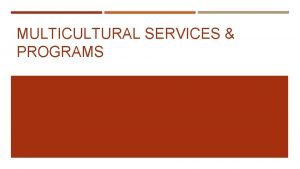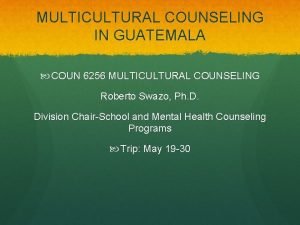Chapter 10 The Youth Culture Multicultural Education in


























- Slides: 26

Chapter 10: The Youth Culture Multicultural Education in a Pluralistic Society, 9 th Edition Donna M. Gollnick and Philip C. Chinn • • • any public performance or display, including transmission of any image over a network; preparation of any derivative work, including the extraction, in whole or in part, of any images; any rental, lease, or lending of the program. Gollnick/Chin Multicultural Education in a Pluralistic Society, 9 e © 2013, by Pearson Education, Inc. All Rights Reserved. 10 -1

Age and Culture We feel, think, perceive, and behave based on the age group to which we belong. An understanding of the various age groups is helpful in understanding and providing appropriately for the needs of students. Gollnick/Chin Multicultural Education in a Pluralistic Society, 9 e © 2013, by Pearson Education, Inc. All Rights Reserved. 10 -2

Young Adulthood Young adulthood is typically defined as ages 18 to 22 or 18 to 25. Young adulthood is a critical period in the life of an individual. Young adults are faced with some of the most important decisions they will ever make, which may have an impact on the rest of their lives. Gollnick/Chin Multicultural Education in a Pluralistic Society, 9 e © 2013, by Pearson Education, Inc. All Rights Reserved. 10 -3

Generation Y are the children of baby boomers and the younger siblings of Generation X. Generation Y is defined by technology and globalization, and social media plays a major role in their lives. Generation Y-ers are considered the most tolerant generation in this country’s history. Gollnick/Chin Multicultural Education in a Pluralistic Society, 9 e © 2013, by Pearson Education, Inc. All Rights Reserved. 10 -4

Generation Z includes those born between 1991 and 2000. Members of the Z Generation were born and grew up with much more advanced technology than their Generation Y counterparts. The technology expertise of the Z Generation poses challenges to educators and parents. Gollnick/Chin Multicultural Education in a Pluralistic Society, 9 e © 2013, by Pearson Education, Inc. All Rights Reserved. 10 -5

Childhood is a critical time in the life of an individual. The educational setting can have a profound influence on the young child. Educators should be concerned for the overall well-being of their students. Gollnick/Chin Multicultural Education in a Pluralistic Society, 9 e © 2013, by Pearson Education, Inc. All Rights Reserved. 10 -6

Social Class and Poverty creates numerous problems for children. Appropriate child care is often difficult for working mothers to provide. Inadequate child care may compromise the child’s socialization and development processes. Gollnick/Chin Multicultural Education in a Pluralistic Society, 9 e © 2013, by Pearson Education, Inc. All Rights Reserved. 10 -7

Children, Ethnic Awareness, and Prejudice Hate crimes and racial violence continue to plague this country. Attention by educators to signs of developing prejudice in young children can have a positive effect in countering its influence. Gollnick/Chin Multicultural Education in a Pluralistic Society, 9 e © 2013, by Pearson Education, Inc. All Rights Reserved. 10 -8

Child Abuse Child abuse is the physical or psychological mistreatment of a child. Abused children may experience serious problems in school, in terms of both disruptive behavior and academic achievement. Child abuse is usually categorized as physical abuse, physical neglect, sexual abuse, or emotional abuse. It is the responsibility of each teacher to report known or suspected cases of child abuse. Gollnick/Chin Multicultural Education in a Pluralistic Society, 9 e © 2013, by Pearson Education, Inc. All Rights Reserved. 10 -9

Physical Abuse Physical abuse refers to nonaccidental injury inflicted by a caretaker. Physical abuse ranges from minor bruises to severe fractures or even death as a result of harming a child. Gollnick/Chin Multicultural Education in a Pluralistic Society, 9 e © 2013, by Pearson Education, Inc. All Rights Reserved. 10 -10

Neglect involves the failure of the parents, guardian, or caregiver to provide for the basic needs of a child. Neglect can involve: • • Physical needs Medical needs Educational needs Emotional needs Gollnick/Chin Multicultural Education in a Pluralistic Society, 9 e © 2013, by Pearson Education, Inc. All Rights Reserved. 10 -11

Sexual Abuse Sexual abuse refers to the involvement of children or underage adolescents in sexual activities. It also includes practices that violate the social mores of one’s culture as they relate to family roles. Gollnick/Chin Multicultural Education in a Pluralistic Society, 9 e © 2013, by Pearson Education, Inc. All Rights Reserved. 10 -12

Emotional Abuse Emotional abuse involves chronically belittling, humiliating, or rejecting a child, or continually attacking their self -esteem. Gollnick/Chin Multicultural Education in a Pluralistic Society, 9 e © 2013, by Pearson Education, Inc. All Rights Reserved. 10 -13

Childhood Obesity The prevalence of childhood obesity in the United States has more than tripled in the last 30 years. Obese children are more likely to have lifelong health issues and face emotional and social problems than their peers. Gollnick/Chin Multicultural Education in a Pluralistic Society, 9 e © 2013, by Pearson Education, Inc. All Rights Reserved. 10 -14

Adolescence is typically defined as ages 13 through 18. It is a long transitional period during which the individual is “suspended” between childhood and adulthood. Emancipation from the primary family unit is the central task of the individual. Gollnick/Chin Multicultural Education in a Pluralistic Society, 9 e © 2013, by Pearson Education, Inc. All Rights Reserved. 10 -15

Relationship with Parents As the adolescent shifts emotional ties from the family to peers, a restructuring may take place in the parent-adolescent relationship. As adolescents assert their rights to assume adult behaviors, they sometimes are unable to assume complementary adultlike responsibilities, which can lead to conflict in families. Gollnick/Chin Multicultural Education in a Pluralistic Society, 9 e © 2013, by Pearson Education, Inc. All Rights Reserved. 10 -16

At-Risk Youth and High-Risk Behaviors At-risk youth are those with a disadvantaged living status. High-risk behaviors are those that youth engage in that make them or others vulnerable to physical, social, or psychological harm or negative outcomes. • High-risk behaviors include the use of harmful substances such as alcohol or other drugs, and sexual behaviors leading to unwanted pregnancies or sexually transmitted diseases. Gollnick/Chin Multicultural Education in a Pluralistic Society, 9 e © 2013, by Pearson Education, Inc. All Rights Reserved. 10 -17

Substance Abuse Substance abuse is the use of banned or illegal drugs and substances or the overuse of legal substances. Substances are abused to produce altered states of consciousness. Adolescent drug users are either experimenters or compulsive users. Gollnick/Chin Multicultural Education in a Pluralistic Society, 9 e © 2013, by Pearson Education, Inc. All Rights Reserved. 10 -18

Adolescent Sexual Behaviors America’s high school students are involved in activities that can lead to pregnancy and STDs, including HIV infection. Sexual activity and high-risk behaviors often have a high correlation with poverty and with states and regions with high levels of poverty. Sexting involves the sending of nude or semi-nude pictures from cell phone to cell phone. Gollnick/Chin Multicultural Education in a Pluralistic Society, 9 e © 2013, by Pearson Education, Inc. All Rights Reserved. 10 -19

Adolescent Suicide is the third leading cause of death among young people. Reasons for the suicide phenomenon include: • the decline in religiosity • tension between parents • the breakup of the nuclear family • family tensions and conflict • substance abuse • the competitiveness of school Educators need to be aware of the warning signs of suicide and self-injury. Gollnick/Chin Multicultural Education in a Pluralistic Society, 9 e © 2013, by Pearson Education, Inc. All Rights Reserved. 10 -20

Adolescent Self-Injury Self-injury or self-mutilation is the deliberate act of harming one’s own body. Most self-injury behaviors begin between the ages of 12 and 15. Adolescents may engage in this behavior to manage painful feelings, cope with anxiety, and relieve stress and pressure. Gollnick/Chin Multicultural Education in a Pluralistic Society, 9 e © 2013, by Pearson Education, Inc. All Rights Reserved. 10 -21

Bullying may involve: • teasing • taunting • verbal abuse • shoving • hitting • spreading rumors • deliberately excluding someone Bullying by peers can have serious long-term consequences for children. Gollnick/Chin Multicultural Education in a Pluralistic Society, 9 e © 2013, by Pearson Education, Inc. All Rights Reserved. 10 -22

Youth Violence Many warning signs of potentially aggressive behavior overlap with the warning signs of individuals considering suicide. Educators need to know the signs of potentially aggressive behavior and depression and refer the individual to a school counselor or to another appropriate authority. Violent television programming may be linked to potentially aggressive behavior. Membership in street gangs is also linked to violent behavior. Gollnick/Chin Multicultural Education in a Pluralistic Society, 9 e © 2013, by Pearson Education, Inc. All Rights Reserved. 10 -23

The Hip-Hop Culture Rap and rap music are a major part of the hip-hop culture. Rap artists have been under increasing criticism for their frequent use of sexist, racist, and violence-laced lyrics. Gollnick/Chin Multicultural Education in a Pluralistic Society, 9 e © 2013, by Pearson Education, Inc. All Rights Reserved. 10 -24

Cell Phones and Texting Cell phones and texting are increasingly important functions in the lives of adolescents. There are dangerous implications of cell phones and texting, including addictions and safety issues while driving. Gollnick/Chin Multicultural Education in a Pluralistic Society, 9 e © 2013, by Pearson Education, Inc. All Rights Reserved. 10 -25

America’s Youth in Today’s Classrooms By addressing the issues of various age groups in the classroom, educators can help students to better understand their siblings, parents, and other important people in their lives. Understanding the particular age group characteristics and needs of students can assist the educator in better understanding and managing age-related behavior. Gollnick/Chin Multicultural Education in a Pluralistic Society, 9 e © 2013, by Pearson Education, Inc. All Rights Reserved. 10 -26
 Multicultural definition ap human geography
Multicultural definition ap human geography Characteristics of multicultural education
Characteristics of multicultural education Multicultural education in a pluralistic society
Multicultural education in a pluralistic society James banks multicultural education five dimensions
James banks multicultural education five dimensions Nieto multicultural education
Nieto multicultural education Goals of multicultural education
Goals of multicultural education Misconceptions of multicultural education
Misconceptions of multicultural education Multiculturalism negative effects
Multiculturalism negative effects Bidialecticism
Bidialecticism Chapter 2 multicultural therapeutic communication
Chapter 2 multicultural therapeutic communication Objectives of youth culture
Objectives of youth culture Chapter 13 section 3 education and popular culture
Chapter 13 section 3 education and popular culture Education and popular culture lesson 5 answer key
Education and popular culture lesson 5 answer key Multicultural counseling theory
Multicultural counseling theory Multicultural london english
Multicultural london english Lisa skriloff
Lisa skriloff Interviewing in action in a multicultural world
Interviewing in action in a multicultural world Circles of my multicultural self
Circles of my multicultural self Troidens model
Troidens model Multicultural primary care
Multicultural primary care Albany park multicultural academy
Albany park multicultural academy Unacquainted-audience presentation
Unacquainted-audience presentation Courtland c lee
Courtland c lee Cultural diversity 3939 answers
Cultural diversity 3939 answers Managing diverse employees in a multicultural environment
Managing diverse employees in a multicultural environment Bp blg. 232
Bp blg. 232 Multicultural literature definition
Multicultural literature definition
